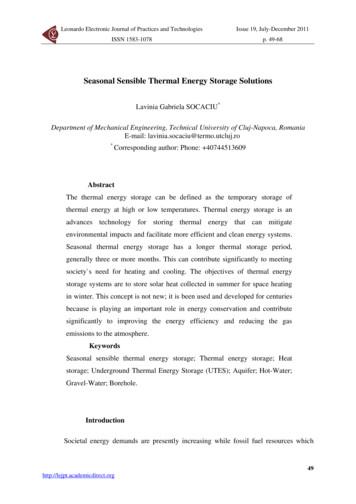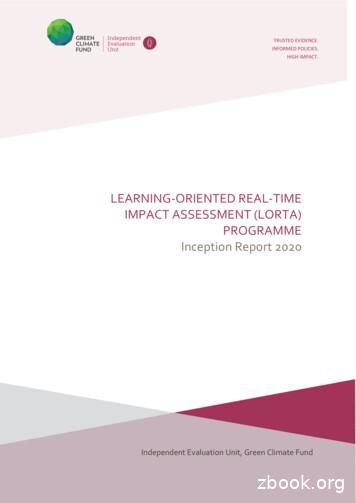Thermal Energy Storage Webinar Series -- Ice Thermal Energy Storage (2020)
Thermal Energy Storage Webinar SeriesIce Thermal Energy StorageBuilding Technologies ng-technologies-officeDavid Nemtzow, Karma Sawyer, Sven Mumme, Nelson JamesJanuary 16, 2020U.S. DEPARTMENT OF ENERGYOFFICE OF ENERGY EFFICIENCY & RENEWABLE ENERGY1
This Webinar is being recorded.If you do not wish to participate, please exit now.U.S. DEPARTMENT OF ENERGYOFFICE OF ENERGY EFFICIENCY & RENEWABLE ENERGY2
Key National Economic and Building Sector Trends: 1980 – 2018U.S. GrossDomestic Product(GDP)300%280%U.S. BuildingSector ElectricityUse260%240%U.S. BuildingSector Floor Area220%200%U.S. BuildingSector EnergyConsumption180%160%140%U.S. Population120%U.S. BuildingSector CO2Emissions100%80%U.S. BuildingEnergy UseIntensity (EUI)60%U.S. DEPARTMENT OF ENERGYOFFICE OF ENERGY EFFICIENCY & RENEWABLE ENERGY3
Energy use in the U.S. building sectorBuilding Electricity UseEnergy Use13%4%Residential21 QuadsTransportation27 QuadsCooling5%Heating72%ElectricWater ooking11%Industrial31 Quads31%ElectricLightingCommercial18 Quads2%3%10%ElectronicsOther ResidentialAppliancesOtherBuildings Energy Use: 40% of U.S. totalBuildings Electricity Consumption: 75% of U.S. totalBuildings Peak Electricity Demand: as much as 80% of regional totalBuildings CO2 Emissions: 36% of U.S. totalU.S. Building Energy Bill: 415 billion per yearU.S. DEPARTMENT OF ENERGYOFFICE OF ENERGY EFFICIENCY & RENEWABLE ENERGY4
BTO’s ApproachR&D (Emerging Technologies Program)Pre-competitive, early-stage investmentin next-gen technologyIntegration (Commercial andResidential Programs)Technology validation, field & labtesting, decision tools, marketintegrationCodes & Standards ProgramsCodes & standards development andtechnical analysis, standardspromulgationWe lead R&D on technologies thatmake our homes and buildings moreaffordable and comfortable, and makeAmerica more sustainable, secure, andprosperous.Our investments strengthen America’s 68 billion building energy efficiencymarketplace.Without a catalyst like BTO, thehousing industry would take 10 to 25years to adopt new technologies andtechniques.FY20 Budget: 285MSource: AEE Advanced Energy Now 2017 Market Report, Wolfe, Raymond M. (2016). Business Research and Development and Innovation: 2013 Detailed Statistical Tables.U.S. DEPARTMENT OF ENERGYOFFICE OF ENERGY EFFICIENCY & RENEWABLE ENERGY5
Moving toward the grid of the futureU.S. DEPARTMENT OF ENERGYOFFICE OF ENERGY EFFICIENCY & RENEWABLE ENERGY6
Characteristics of Grid-interactive Efficient Bldgs.www.energy.gov/eere/buildings/GEBU.S. DEPARTMENT OF ENERGYOFFICE OF ENERGY EFFICIENCY & RENEWABLE ENERGY7
Energy Storage Grand ChallengeVision: By 2030, the U.S. will be the world leader in energystorage utilization and exports, with a secure domesticmanufacturing supply chain independent of foreign sources ofcritical materials.Area 1: Near-Term Acceleration Enhance the diversity of storage and enablingtechnologies to meet aggressive cost reductions andperformance improvements.Area 2: Long-Term Leadership Strengthen the R&D ecosystem to maintain and grow USstorage leadership through constant innovation.U.S. DEPARTMENT OF ENERGYOFFICE OF ENERGY EFFICIENCY & RENEWABLE ENERGY8
Energy Storage Grand ChallengeESGC sets the following goals for the U.S. to reach by 2030: Technology Development: Establish ambitious, achievable performance goals, anda comprehensive R&D portfolio to achieve them Technology Transfer: Accelerate the technology pipeline from research to systemdesign to private sector adoption through rigorous system evaluation, performancevalidation, siting tools, and targeted collaborations; Policy and Valuation: Develop best-in-class models, data, and analysis to informthe most effective value proposition and use cases for storage technologies; Manufacturing and Supply Chain: Design new technologies to strengthen U.S.manufacturing and recyclability, and to reduce dependence on foreign sources ofcritical minerals; and Workforce: Train the next generation of American workers to meet the needs of the21st century electric grid and energy storage value e/energy-storage-grand-challengeU.S. DEPARTMENT OF ENERGYOFFICE OF ENERGY EFFICIENCY & RENEWABLE ENERGY9
Today’s WebinarMarcus BianchiSenior Research EngineerNational Renewable Energy LaboratoryRichie SteverDirector of Operations and MaintenanceUniversity of Maryland Medical Center’sDowntown and Midtown CampusesU.S. DEPARTMENT OF ENERGYOFFICE OF ENERGY EFFICIENCY & RENEWABLE ENERGYMark MacCrackenVP, CALMAC PortfolioTRANE Inc.Heather JacksonInnovation ConsultantArizona Public Service10
Energy Storage: Batteriesand Thermal EnergyMarcus V.A. Bianchi, Ph.D., P.E.Building and Thermal Sciences Center, NRELJanuary 16, 2020
Thermal Energy Storage for BuildingsElectrical Consumption for HomesThermal End-Uses Dominate BuildingEnergy Consumption HVAC and refrigeration– Major drivers of peak demand– Easiest electrical load to shift Thermal storage has benefits– Higher roundtrip efficiencythan batteries for HVAC– Batteries are charged withhigher value energy– Capital cost could be far lower– Lifetime could be far greaterNREL 12
Thermal Energy Storage Examples Sensible– Adobe– Hot or chilled water– Underground systems (borehole, aquifer, cavern) Latent– Phase change materials (ice, paraffin) Chemical– Sorption of waterNREL 13
Example of Ice Storage SystemNREL 14
Peak Shifting during CoolingNREL 15
Peak Shifting during CoolingNREL 16
Thank Youwww.nrel.govMarcus.Bianchi@nrel.gov
Thermal Energy Storage:The Need, the Successes theChallenges and the Opportunities Mark MacCracken, PE, Pte, LEED FellowPresident of CALMAC, a portfolio of Tranemm@calmac.comCALMAC is a portfolio of Trane
Stored EnergyEnergyWhere is the storage?
Net Zero Grid Building:Wind TurbineSolar PanelzeroBatteriesFossil FuelsThermal StorageDesigners tend to remove buildingsited renewable back up equipment
Buildings becoming part of thestorage and distribution systemBNEF projectionsof storagedeployment overthe next decade
Building Side (of meter) Energy Storage TechnologiesBatteryThermal Energy Storage(TES) Hot, Cold or Ice, Active or Passive
Basic Thermal Storage
Thermal StorageHow many lbs. of ice do you need for eachperson for a party? 1 lbs.How many lbs. of ice do you need each day to cool each personin a typical office building?ArchitectEngineer100 ft2/per person300 ft2/ton200 ft2/per person400 ft2/ton500 ft2/ton100 ft2/pp / 400 x 8hr 2 ton-hrs 160 lbs of Ice/Person/Day200 ft2/pp / 400 x 10hr. 5 ton-hrs 400 lbs of Ice/Person/Day
Utility Load Factors* in the USA706560%5550451955 1965 1975 1985 1995 2005 2015Year*Load Factor Avg. LoadPeak Load
40% of AC
CALMAC US Projects Histogram 3DCALMAC has installed 530 MW / 3,422 MWH of TESstorage systems in the US. At the end of 2017, the batteryindustry had 25% more peak demand thanTrane/CALMAC but only 1/4 of the capacity *Installed base concentratedwhere Grid ISO’s are active!*Energy Information /electricity/batterystorage/32
Why not more TES? Fossil Fuels come with Free Storage Lack of awareness of Electrical costs, 50% less at night Perceived more “risk” in the design phase (moreeffort) because “Modeling” is difficult. Only for cooling season:“Electrification” of Buildings willenable Thermal Energy Storage toadd value 12 months of the year33
Electricity is 50% Less Expensive at NightConsumers Energy (Mich.) General Primary rateEnergy (usage):Day: 0.085/kWhNight: 0.085/kWh 0.170/kWh 0.085/kWhDemand: 14.00/kW/Month
Jefferson Community College- Watertown, NY
Thermal Energy Storage Myths Article1.2.3.4.5.6.7.8.UncommonToo Much SpaceToo ComplicatedDoesn’t Save EnergyToo ExpensiveLack of Redundancy (Risky)Rates Will ChangeModeling doesn’t Show ResultsReality:TES is a Proven Technology that saves Money and Energy
Electrification Big Heat Pumps Chillers are Big Heat Pumps, but only pump theenergy in one direction (not reversible) Water Cooled Chillers Water to Water Heat Pumps
Thermal Batteries You know these as “Ice Storage Tanks” They are actually Thermal Batterieso When you take energy out, the water turns to iceo When you put energy in, the ice melts
Water’s Phase Change (Btus)1 match takes 1lb. of waterfrom32F to 33F144 matches takes1 lb. of water from32F Ice to 32F waterChanging Water’s Phase(solid to liquid) storestremendous amounts ofthermal energy1 Match144 Matches
Winter Simultaneous Heating & CoolingCooling TowerDuring the winter months, most large NewYork City buildings simultaneously heatand cool.Interior andPerimeter ZonesPerimeter zones in thebuilding’s shell They cool with waterside economizers At the same time, they heat the buildingwith natural gas boilers or steamSome call waterside economizers “free cooling”which is a misnomer.This process wastes energy that the HVAC plantcould efficiently use to warm the perimeterzones.Boiler Chiller
45
LET’S GO BEYOND Mark M. MacCrackenmm@calmac.comTrane, the Circle Logo, and Let’s Go Beyond, Thermal Battery, CALMAC, are trademarks of Trane in the United States and other countries. 2019 Trane. All Rights Reserved.
Uses and Lessons of Ice Storage onthe Medical CampusBuilding Technologies Office WebinarRichie SteverDirector of Operations and MaintenanceJanuary 16, 2020
ABOUT THE MEDICAL CENTER757 bed academic teaching hospital31 ORs8600 employees2.5 million square feetHospital: 2,100,000sqftMedical Office Buildings:121,000sqftParking Garage: 309,000sqft 14 million on energy bills a year500,000 gallons of water a day48
HVAC/REFRIGERATION2 – Ice Storage Tanks13 – Cooling Towers14 – Chillers56 – Air Handling Units64 – Exhaust Fans95 – Ice Machines148 – Fan Coil Units156 – Isolation/Protective Environment Rooms521 - Refrigerators49
Electrical Usage 2019Average: 700,956/month40,000,000 1,000,000 900,00035,000,000 800,00030,000,00025,000,000 600,00020,000,000 500,000( )ELECTRICITY UNIT 700,000 400,00015,000,000 300,00010,000,000 200,0005,000,000 100,0000 0123456789101112MONTHkBtuCost50
Steam Usage 2018Average: 227,288/month35,000,000 600,00030,000,000 500,00025,000,00020,000,000 300,000( )STEAM UNIT 400,00015,000,000 200,00010,000,000 100,0005,000,0000 0123456789101112MONTHkBtuCost51
BAS MONITORINGUtility Dashboard52
COMPOUND HEAT RECOVERY CHILLERManufacturer: YorkCapacity: 500 tonsCompressor: Two Stage CentrifugalEvaporator Water is used to Chill GlycolTemperature: 26 - 32FCondenser Water is use for Heating WaterTemperature:140F53
ICE PLANT54
ICE STORAGE TANKManufacturer: BaltimoreAircoil CompanyCapacity: 4200 tonsInterior View of Ice Tank Glycol CoilConsists of 4 doublewalled tanks with coppercoils inside. Chilled glycol( 32F) produced by theheat recovery chiller is runthrough the coils to coolthe water around them,bubblers are used toprevent freezing anddiscourages temperaturevariations.55
PROCESS COOLING LOOPAn independent chilledwater loop for coolingheavy metal equipment,such as MRIs and otherhigh power medicalscanner devices. Icewater is used tosupplement cooling whennecessary.56
AIR HANDLER UPGRADES57
Peak ShavingReduces capacity charges ( 100k/MW)Status,UMMS9/11/2009Portfolio Electric HedgeUMMSStatus,Portfolio9/11/2009Electric Hedge Status,UMMS9/11/2009Portfolio Electric Hedge Status, geTotal Purchased Max Hedge Min Hedge PurchasedTotalPeak CallMaxMinHedgeHedgePurchasedPJM PeakMin Hedge58
Pros and Cons of Ice StorageProsProvides redundancy via thermal storageStable water temperaturesAbility to peak shavePotential energy savings (off-peak usage)Low maintenanceConsHigh first costsFlood potentialRequires Space59
Questions?60
Ice Storage in ArizonaHeather Jackson1/16/2020
Affordable.Grid Benefits?Sustainable?62
For utilities and building owners: Find each other!– District cooling,schools, hospitals,hotels, cold storagewarehousesCreate a triple win– System owner– Utility– environmentDistrictLarge facility63
Energy Storage scale and cost Existing infrastructure– District cooling: 10’s of MWh– Large facility: MWh scale New infrastructure– Already cost-competitive forhigh density cooling loads– Special rates– Utility incentives?64
What we’re doing to expand icestorage in Arizona Connecting with owners of icestorage systems Rates– Make ice when renewables areabundant Incentive Programs: must societalcost test Finding large / new cooling loads65
66
Value for the Power GridDistrict Cooling loadscould function like 3 10M batteriesLarge facility coolingloads could functionlike 500k - 3MbatteriesSeasonality: Minimumcooling load?67
How can utilities help drive adoptionof ice storage cooling? Please reach out with ideas Heather.Jackson@aps.com68
OPEN Q&ASubmit Questions via chat boxU.S. DEPARTMENT OF ENERGYOFFICE OF ENERGY EFFICIENCY & RENEWABLE ENERGY69
Thermal Energy Storage Webinar SeriesStay tuned for the next installmentU.S. DEPARTMENT OF ENERGYOFFICE OF ENERGY EFFICIENCY & RENEWABLE ENERGY70
enable Thermal Energy Storage to add value 12 months of the year. Electricity is 50% Less Expensive at Night Consumers Energy (Mich.) General Primary rate Energy (usage): Day: 0.085/kWh Night: 0.085/kWh Demand: 14.00/kW/Month 0.085/kWh 0.170/kWh. Jefferson Community College- Watertown, NY. Thermal Energy Storage Myths Article
3. Thermal Energy Storage 18 3.1 Thermal Energy Storage Approaches 19 3.2 Sensible Heat Storage 19 3.3 Large-Scale Sensible Heat Stores 22 3.4 Latent Heat Storage 25 3.5 Thermochemical Heat Storage 28 3.6 Summary 29 4. Potential for Thermal Energy Storage in the UK Housing Stock 30 4.1 Introduction 31 4.2 The Approach Adopted 31 4.3 Modelling 31
The thermal energy storage can be defined as the temporary storage of thermal energy at high or low temperatures. Thermal energy storage is an advances technology for storing thermal energy that can mitigate environmental impacts and facilitate more efficient and clean energy systems.
The electrical energy is transformed into thermal energy by the heat sources. The thermal energy has to meet the demand from the downstream air-conditioning system. Thermal en-ergy storage systems can store thermal energy for a while. In other words the storages can delay the timing of thermal energy usage from electricity energy usage. Fig. 1 .
changes to thermal energy. Thermal energy causes the lamp's bulb to become warm to the touch. Using Thermal Energy All forms of energy can be changed into thermal energy. Recall that thermal energy is the energy due to the motion of particles that make up an object. People often use thermal energy to provide warmth or cook food. An electric space
Summer 2018 SEVP InFocus Webinar—Script . 1 . Summer 2018 SEVP InFocus Webinar . Aug. 16, 2018 . Webinar Script . Slide 1: Pre-webinar Title Slide [Adobe Connect room opens approximately 15 minutes prior to webinar. Slide 1
3. Webinar 3 - Evaluation questions and indicators 4. Webinar 4 -Experimental impact evaluation 5. Webinar 5 -Non experimental impact evaluation 6. Webinar 6 - Sample size and power calculations 7. Webinar 7 - Timeline and budget 8. Webinar 8 - Rapid-fire presentations and closing remarks For all webinars except webinar 8, a learning
Winter 2018 SEVP InFocus Webinar Dec. 12, 2018 Webinar Script Slide 1: Pre-webinar Title Slide [Adobe Connect room opens approximately 15 minutes prior to webinar. Slide 1 displays until the start of the webinar at 2 p.m. EST.] Slide 2: Title Slide ALEXIS: Hello everyone! I'm Alexis Gioia, and I am the field representative for .
STORMBREAKER AnthonyHorowitz FUNERALVOICES WHENTHEDOORBELLringsatthreeinthemorning itsnevergoodnews AlexRiderwaswoken , ' . bythefirstchime Hiseyesflickeredopen .























